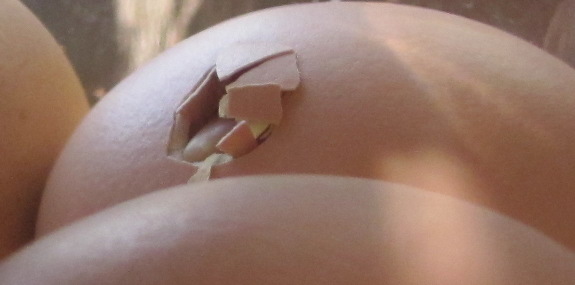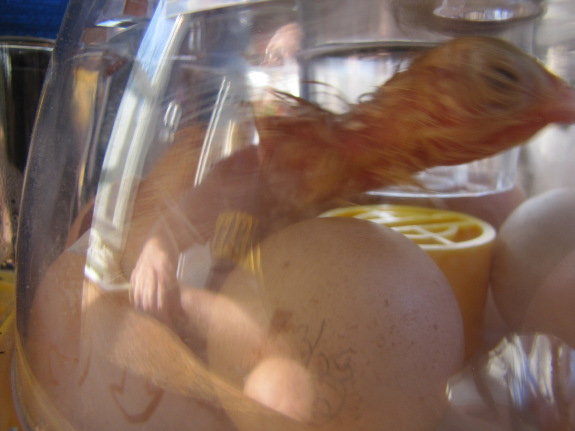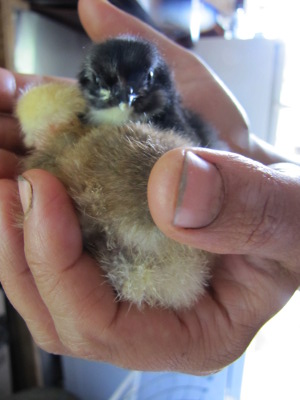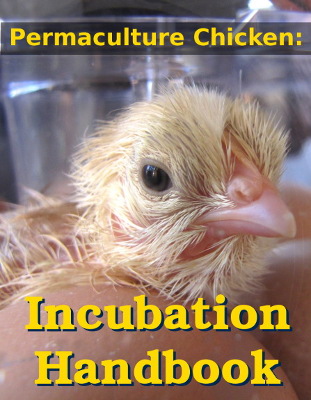
Chicks hatching
 The most exciting part of the incubation
process can also be the most
traumatic if you don't know what you're doing. This final post in
the lunchtime series
tells you what to expect during hatch time, but the
99 cent ebook from which the post is drawn covers much more
information. I hope you'll splurge a buck if you want to learn
more about preparing for the hatch, helping chicks out of the shell,
troubleshooting incubation problems, and getting your youngsters off to
a healthy start.
The most exciting part of the incubation
process can also be the most
traumatic if you don't know what you're doing. This final post in
the lunchtime series
tells you what to expect during hatch time, but the
99 cent ebook from which the post is drawn covers much more
information. I hope you'll splurge a buck if you want to learn
more about preparing for the hatch, helping chicks out of the shell,
troubleshooting incubation problems, and getting your youngsters off to
a healthy start.
 You'll probably see at least
one chick pipping (pecking the initial
hole into its shell) on day 19 or 20. I like to record the date
and time each egg pips to give me an
indication of whether chicks are having trouble. I explain how
and when to help chicks in another section, but for now, just be aware
that it's very normal to see a delay of 8 to 12 hours between pipping
and unzipping (when the chick severs the blunt end of the shell and
breaks its way free). But if a chick has pipped but not begun to
unzip 24 hours later, it might be in trouble.
You'll probably see at least
one chick pipping (pecking the initial
hole into its shell) on day 19 or 20. I like to record the date
and time each egg pips to give me an
indication of whether chicks are having trouble. I explain how
and when to help chicks in another section, but for now, just be aware
that it's very normal to see a delay of 8 to 12 hours between pipping
and unzipping (when the chick severs the blunt end of the shell and
breaks its way free). But if a chick has pipped but not begun to
unzip 24 hours later, it might be in trouble.
 If you've done a good job
with all of the early incubation steps, your
chicks will probably pop right out of their shells one after another
with no help from you. Some manuals recommend leaving your chicks
in the incubator for an entire day without lifting the lid to allow the
youngsters to
dry off completely, but I've had much better luck plucking chicks out
of the incubator within 45 minutes of hatching and either plopping them
into the brooder to finish drying off or placing them in a smaller
incubator.
If you've done a good job
with all of the early incubation steps, your
chicks will probably pop right out of their shells one after another
with no help from you. Some manuals recommend leaving your chicks
in the incubator for an entire day without lifting the lid to allow the
youngsters to
dry off completely, but I've had much better luck plucking chicks out
of the incubator within 45 minutes of hatching and either plopping them
into the brooder to finish drying off or placing them in a smaller
incubator.
 The trouble with leaving
chicks in the incubator after they hatch is
that the baby birds will stumble around madly, rolling eggs and (in the
worst case scenario) spearing partially hatched chicks with their
claws. In my experience, newly hatched chicks are upset by not
having
anything soft to snuggle into, so they keep hopping around even though
they're exhausted. Once I pop a newly hatched chick under our
brooder, it stops peeping shrilly and soon falls
asleep.
The trouble with leaving
chicks in the incubator after they hatch is
that the baby birds will stumble around madly, rolling eggs and (in the
worst case scenario) spearing partially hatched chicks with their
claws. In my experience, newly hatched chicks are upset by not
having
anything soft to snuggle into, so they keep hopping around even though
they're exhausted. Once I pop a newly hatched chick under our
brooder, it stops peeping shrilly and soon falls
asleep.
 There are two downsides to
removing chicks from the incubator one at a
time throughout the hatch process. Chicks
come out of the shell soaked to the skin and can easily catch a chill,
especially if you're hatching in cold weather. Forty-five minutes
in the incubator is just long enough that the chick's feathers are
(mostly) dry, but is not long enough that they puff up into the
protective
ball of fuzz most of us think of when we envision a chick. In
warm weather (and even in cold weather if there are at least two or
three other chicks in the brooder for the newly hatched youngster to
snuggle into), this level of dry off is enough. However, if your
first chick comes out of the shell when your room temperature is below
about 50 degrees Fahrenheit, you should either put up with the
problems caused by leaving the chick in the main incubator until at
least one
more chick hatches and dries, or should place the newly hatched chick
in a
spare incubator for a few hours. You'll be able to tell if you
put a too-wet chick into a too-cold brooder because it will keep
chirping frantically rather than quieting down after a minute or two.
There are two downsides to
removing chicks from the incubator one at a
time throughout the hatch process. Chicks
come out of the shell soaked to the skin and can easily catch a chill,
especially if you're hatching in cold weather. Forty-five minutes
in the incubator is just long enough that the chick's feathers are
(mostly) dry, but is not long enough that they puff up into the
protective
ball of fuzz most of us think of when we envision a chick. In
warm weather (and even in cold weather if there are at least two or
three other chicks in the brooder for the newly hatched youngster to
snuggle into), this level of dry off is enough. However, if your
first chick comes out of the shell when your room temperature is below
about 50 degrees Fahrenheit, you should either put up with the
problems caused by leaving the chick in the main incubator until at
least one
more chick hatches and dries, or should place the newly hatched chick
in a
spare incubator for a few hours. You'll be able to tell if you
put a too-wet chick into a too-cold brooder because it will keep
chirping frantically rather than quieting down after a minute or two.
 The other issue with
removing chicks from the incubator one by one is
that every time you lift the lid, the incubator cools slightly and the
humidity levels drop. You can counteract this problem to some
extent with speed --- open the lid with one hand while you snag the
chick with the
other. If it's pretty cold in the room, I like to heat up some
water until it's steaming and top off the wells when I take off the
incubator lid since the hot water will keep the temperature in the
incubator high and will also increase the humidity drastically.
Using an evaporating cloth (explained in another section) also helps
keep the humidity within the incubator at a high level.
The other issue with
removing chicks from the incubator one by one is
that every time you lift the lid, the incubator cools slightly and the
humidity levels drop. You can counteract this problem to some
extent with speed --- open the lid with one hand while you snag the
chick with the
other. If it's pretty cold in the room, I like to heat up some
water until it's steaming and top off the wells when I take off the
incubator lid since the hot water will keep the temperature in the
incubator high and will also increase the humidity drastically.
Using an evaporating cloth (explained in another section) also helps
keep the humidity within the incubator at a high level.
 Even
though it's not 100% necessary, I open the lid a second time after
the new chick is safely ensconced in the brooder, this time to tidy up
the interior of the incubator. I remove large pieces of eggshell
so chicks won't cut themselves on the sharp edges and I roll any
disturbed eggs over so their pipping holes are facing up.
(Sometimes, a chick will stumble across a neighboring egg and turn that
chick face down, which makes it harder for the down-turned chick to
hatch.)
Finally, I quickly move eggs around so that ones likely to
hatch soonest have a little more open space around their blunt
ends. As with removing the chick, I work quickly to ensure I
don't lower the temperature and humidity in the incubator enough that
it doesn't rebound a few minutes after I close the lid.
Even
though it's not 100% necessary, I open the lid a second time after
the new chick is safely ensconced in the brooder, this time to tidy up
the interior of the incubator. I remove large pieces of eggshell
so chicks won't cut themselves on the sharp edges and I roll any
disturbed eggs over so their pipping holes are facing up.
(Sometimes, a chick will stumble across a neighboring egg and turn that
chick face down, which makes it harder for the down-turned chick to
hatch.)
Finally, I quickly move eggs around so that ones likely to
hatch soonest have a little more open space around their blunt
ends. As with removing the chick, I work quickly to ensure I
don't lower the temperature and humidity in the incubator enough that
it doesn't rebound a few minutes after I close the lid.
 This post is part of our Chicken Incubation lunchtime series.
Read all of the entries: This post is part of our Chicken Incubation lunchtime series.
Read all of the entries: |
Want more in-depth information? Browse through our books.
Or explore more posts by date or by subject.
About us: Anna Hess and Mark Hamilton spent over a decade living self-sufficiently in the mountains of Virginia before moving north to start over from scratch in the foothills of Ohio. They've experimented with permaculture, no-till gardening, trailersteading, home-based microbusinesses and much more, writing about their adventures in both blogs and books.
Want to be notified when new comments are posted on this page? Click on the RSS button after you add a comment to subscribe to the comment feed, or simply check the box beside "email replies to me" while writing your comment.

I've gotten through the intro of the newest ebook. I love the description of your first hatch. It sounds like a lot of fun to raise chicks this way, but I would much sooner get chicks 3 or more weeks old than try to raise them from tiny fluffballs. Our Feed Store is pretty good at keeping stocked with desirable breeds and it's much easier to let them suffer the early losses and pay the same price for older, stronger chicks. That said, I'm not raising more than 4-6 chicks a year, and mostly just pullets for laying.
I've honestly never considered incubating, because I remember my grandfather trying when I was younger and he threw in the towel. Luckily, he had no trouble with broody hens raising their own (especially the cochin, or cochin crosses-- we didn't know their full history, but they were small with feathered feet). He always had an interesting assortment of little bantam chicks running around. I think he ended up with purebred and hybrids of Lakenvelder, Golden Penciled Hamburgs, Black Rosecombs, Partridge Rocks, the cochin crosses and maybe a few others that I'm not remembering. Those were fun times.